Related Research Articles

The Airspeed AS.57 Ambassador is a British twin piston-engined airliner that was designed and produced by the British aircraft manufacturer Airspeed Ltd. It was one of the first postwar airliners to be produced.

The Bristol Type 167 Brabazon was a large British piston-engined propeller-driven airliner designed by the Bristol Aeroplane Company to fly transatlantic routes between the UK and the United States. The type was named Brabazon after the Brabazon Committee and its chairman, Lord Brabazon of Tara, who had developed the specification to which the airliner was designed.

The Rolls-Royce RB.53 Dart is a turboprop engine designed and manufactured by Rolls-Royce Limited. First run in 1946, it powered the Vickers Viscount on its maiden flight in 1948. A flight on July 29 of that year, which carried 14 paying passengers between Northolt and Paris–Le Bourget Airport in a Dart-powered Viscount, was the first regularly scheduled airline flight by a turbine-powered aircraft. The Viscount was the first turboprop-powered aircraft to enter airline service - British European Airways (BEA) in 1953.

The Hawker Tornado was a British single-seat fighter aircraft design of the Second World War for the Royal Air Force as a replacement for the Hawker Hurricane. The planned production of Tornados was cancelled after the engine it was designed to use, the Rolls-Royce Vulture, proved unreliable in service. A parallel airframe that used the Napier Sabre engine continued into production as the Hawker Typhoon.
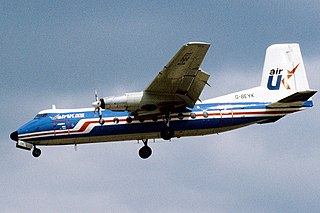
The Handley Page Dart Herald is a 1950s British turboprop passenger aircraft.
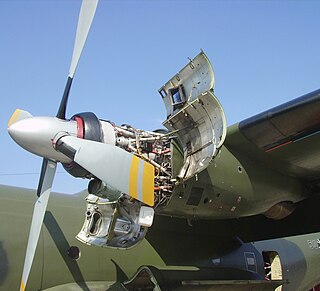
The Rolls-Royce RB.109 Tyne is a twin-shaft turboprop engine developed in the mid to late 1950s by Rolls-Royce Limited to a requirement for the Vickers Vanguard airliner. It was first test flown during 1956 in the nose of a modified Avro Lincoln. Following company naming convention for gas turbine engines this turboprop design was named after the River Tyne.

The Avro Type 688 Tudor was a British piston-engined airliner based on Avro's four-engine Lincoln bomber, itself a descendant of the famous Lancaster heavy bomber, and was Britain's first pressurised airliner. Customers saw the aircraft as little more than a pressurised DC-4, and few orders were forthcoming, important customers preferring to buy US aircraft. The tailwheel undercarriage layout was also dated and a disadvantage.

The Supermarine Scapa was a British general reconnaissance flying boat built by Supermarine that was used by the Royal Air Force between 1935 and 1939. It was developed from the Southampton and formed the basis of the later Stranraer flying boat.

The Handley Page W.8, W.9 and W.10 were British two- and three-engine medium-range biplane airliners designed and built by Handley Page.
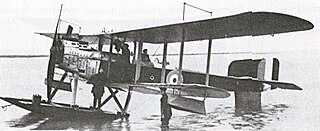
The Fairey Campania was a British ship-borne, patrol and reconnaissance aircraft of the First World War and Russian Civil War. It was a single-engine, two-seat biplane with twin main floats and backward-folding wings. The Campania was the first aeroplane ever designed specifically for carrier operations.

The Avro 604 Antelope was a British light bomber which was designed and built in the late 1920s to meet a requirement for a light bomber to equip the Royal Air Force, competing against the Hawker Hart and the Fairey Fox II. It was unsuccessful, the Hart being preferred.

The Avro 701 Athena is a British advanced trainer aircraft built by Avro in the late 1940s. It was designed to replace the North American Harvard in the Royal Air Force, but was bought only in small numbers, the competing Boulton Paul Balliol being preferred.

The Gloster SS.35 Gnatsnapper was a British naval biplane fighter design of the late 1920s. Two prototypes were built but the type did not enter production.

The Supermarine Type 322 was a prototype British carrier-borne torpedo, dive bomber and reconnaissance aircraft of the Second World War. A single-engined monoplane, it was unsuccessful, with only two examples being built. The Fairey Barracuda, built to the same specification, would fill this role.
The Westland Yeovil was a British biplane bomber designed and built by Westland Aircraft in 1923 to meet an Air Ministry Specification for a single-engined day bomber.

The Westland Wizard was Westland Aircraft's first attempt to produce a monoplane fighter. The project was privately funded and the prototype design was done in the spare time of the company's engineers. This all happened during 1926, with high-speed performance as the primary goal.
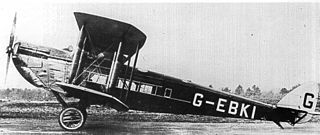
The de Havilland DH.54 Highclere was a single-engined 15-passenger biplane airliner designed to replace the DH.34. Its development ended when Imperial Airways decided to use only multi-engined types.

The Fairey N.4 was a 1920s British five-seat long range reconnaissance flying boat. Designed and built by the Fairey Aviation Company to meet an Admiralty requirement for a very large four-engined reconnaissance aircraft, it was the world's biggest flying boat when it first flew in 1923.
The Bristol Type 159 was a British design for a four-engined heavy bomber by the Bristol Aeroplane Company, of Filton, Bristol. A mockup was built but the project was cancelled and no aircraft were built.
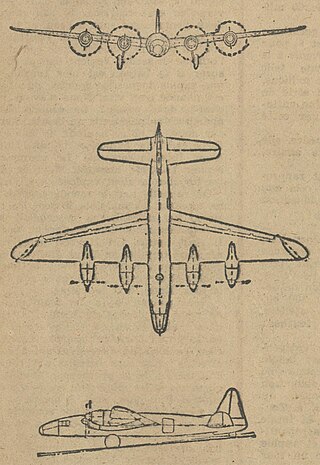
The SNCASE SE-1010 was a late 1940s French photo-survey aircraft designed and built by SNCASE for the Institut Géographique National, one prototype was built but it crashed and the project was cancelled.
References
- ↑ Woyevodsky, Nicolas. "US 1391355 A". Google Patent Search. USPTO.
- ↑ The Westland Dreadnought had been built to test Woyevodsky's ideas in 1924
- 1 2 Brown, Don L. (1970). Miles Aircraft since 1925 (1st ed.). London: Putnam & Company Ltd. pp. 128-130, 202–204, 246–248, 257–265. ISBN 0-370-00127-3.
- ↑ Flight likened it to the " Nurflügel (all-wing) aircraft visualised more than twenty years ago by the late Professor Junkers"
- ↑ Flight 21 April 1938 p 378
- ↑ Flight 1943 p 703
- ↑ Flight 28 April 1938 p 411
- "The Miles X", Flight, pp. 703–705, 23 December 1943